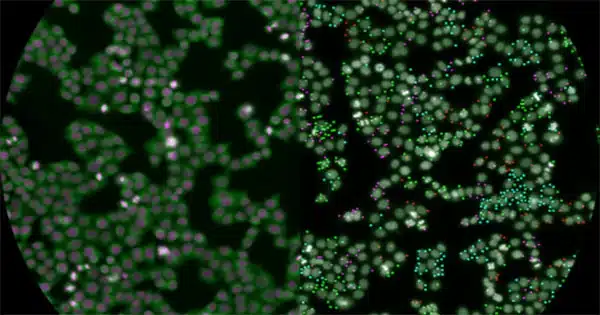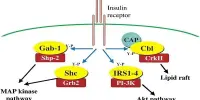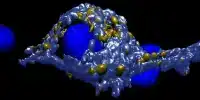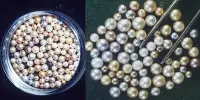Collaborative research at the University of Cincinnati has resulted in the development of a new probe for better-studying cells, which has already resulted in new knowledge about specific cellular processes.
Jiajie Diao and Yujie Sun of UC are the principal authors of a new study published in ACS Sensors.
The team’s research focused on endolysosomes, which are organelles or specialized structures that serve numerous functions inside cells. Endolysosomes are a subtype of lysosomes that originate as a separate organelle termed an endosome. Lysosomes work as the “recycling center” of the cell, reusing broken or defective building pieces for various reasons.
Lysosomes are an important organelle to research because abnormalities can result in lysosomal storage disorders, which cause toxic chemical buildup in cells. Lysosome dysfunction has also been linked to neurological disorders and cancer.
“If the lysosomes aren’t working properly, the cell will accumulate a lot of waste, eventually leading to cell death,” said Diao, a member of the University of Cincinnati Cancer Center and an associate professor in the Department of Cancer Biology in the UC College of Medicine.
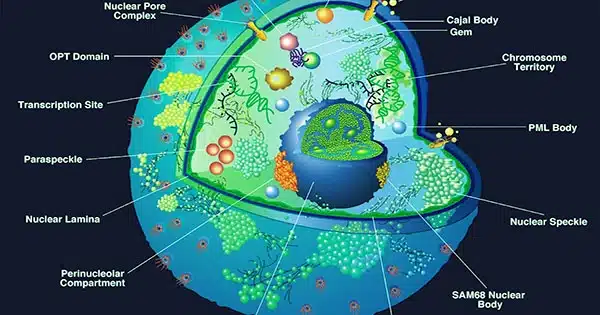
These organelles shift their pH values from a neutral to an acidic environment during the transition from an endosome to a lysosome. Lysosomes cannot execute their functions of cleaning and recycling trash properly if the environment is not acidic enough.
“We’re trying to image this process and track the entire changing process of the endolysosome to figure out in which state and which location these endolysosomes will become abnormal,” Diao explained.
New probe: Last year, Diao and Sun’s team released research on the ECGreen probe, which changes color when the cell environment becomes more acidic. ECGreen, while a step forward, nevertheless has limitations, according to Diao.
“It’s difficult to estimate the absolute value because all I know is that it’s decreased,” Diao remarked. “The intensity rises, but how high is high?” There is no way you can adjust this figure.”
The team’s most recent probe is green in a neutral environment and red when the cell environment becomes more acidic.
“So we have red and green signaling, and by calculating the ratio, we can calibrate the exact pH value,” Diao explained. “Measuring the pH inside the endolysosome is more robust and precise, so this is a significant advantage.”
“Our probe exhibits excellent pH-sensitive fluorescence in endolysosomes at different stages of interest,” Sun, a Cancer Center member, associate professor, and graduate program co-director in UC’s Department of Chemistry, stated.
Research in action: When a cell’s environment changes, such as when it is damaged, the number of lysosomes must rise in order to recycle or clean up the cell. However, the process by which cells increase the number of lysosomes was previously unknown.
Using the novel probe, the researchers discovered that regardless of the environment a cell is in or whether it is normal or abnormal, it will maintain a fixed ratio of endosomes that it then transforms into lysosomes.
“We were able to reveal a constant conversion rate from early endosomes to late endosomes/lysosomes by using the small molecular probe in live cells,” Sun added. “We are very pleased that we were able to reveal this consistent conversion rate.”
Diao stated that the researchers discovered for the first time that the route from the endosome to the lysosome is governed by a complex protein-controlled process.
“This process is highly regulated, and you cannot skip any steps, even if it’s an emergency,” Diao said.
Probe applications: Diao stated that, in addition to the purposes indicated in the published research, the novel probe has a lot of other applications.
“We can know the location of the endolysosome, the number, the pH change, and the size of the endolysosome,” he explained. “Eventually, we will have all of the parameters about the endolysosomes inside the cell.”
With this information, the team is attempting to create machine-learning software that can profile cell irregularities and swiftly diagnose lysosome disorders that can lead to diseases.
This procedure would be faster and less expensive than current gene and protein sequencing, and it might be as simple as a healthy patient having a simple blood test to see if they are at risk for certain lysosomal disorders.
“You just need to do staining, and you’ll have all the information in 10 minutes,” Diao explained. “We’re actually trying to develop a system with these probes so we can do fast diagnosis.”
The researchers are also investigating treatments that alter the process of transition from endosome to the lysosome in order to speed up the difficult process, including light studies.
“Our findings show that it is an extremely promising direction in designing and developing small fluorescent probes for bioimaging applications, particularly when combined with high-resolution microscopy,” Sun added. “We will continue developing novel fluorescent probes with multiple functions.”
The other University of California researchers have begun to use the probe, and the team is attempting to patent and commercialize the technique.
“I think this is a really classic work resulting from the collaboration,” Diao added. “Dr. Sun and our team collaborate, and we actually make the entire process very fast and efficient.” We want to speed all of this research.”
“The complementary expertise of Dr. Diao’s and my own groups really makes working on these collaborative projects possible,” Sun noted. “The key to our success is the synergistic interaction between our groups.”
